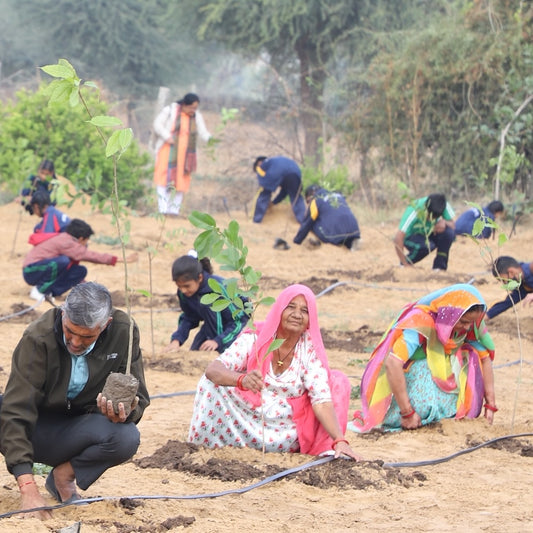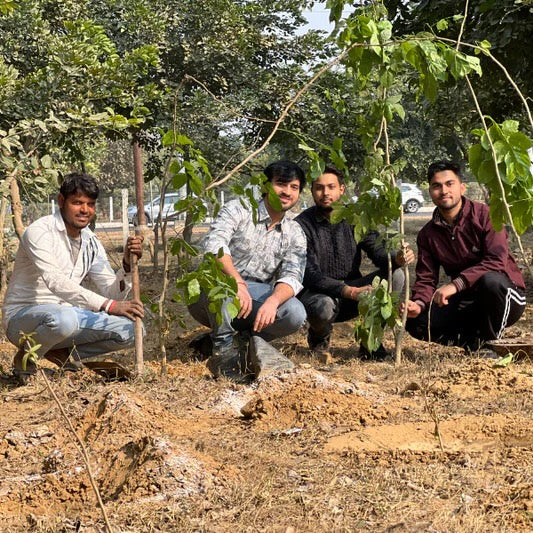In the face of accelerating climate change, resource depletion, and environmental degradation, the role of corporations in combating these issues has Read more
In the face of accelerating climate change, resource depletion, and environmental degradation, the role of corporations in combating these issues has never been more critical.
Planting trees has emerged as one of the simplest yet most impactful ways for businesses to align with sustainability goals, boost employee morale, and improve their public image.
But why exactly should corporates prioritize tree-planting initiatives? Let’s dive into the science, history, and practical benefits of "Trees for Corporates."
The Environmental Case for Trees 🌿
1. Carbon Sequestration and Climate Change Mitigation
Trees act as natural carbon sinks, absorbing CO2—a leading greenhouse gas—from the atmosphere. A mature tree can absorb approximately 48 pounds of carbon dioxide annually. Forests collectively absorb about 2.4 billion tons of CO2 every year, equivalent to one-third of all CO2 emissions from burning fossil fuels.
For corporates, planting trees isn’t just an act of goodwill; it’s a direct way to offset their carbon footprint.
Partnering with organizations like the Trillion Trees Initiative can amplify these efforts, contributing to the global goal of planting one trillion trees to combat climate change.
2. Air Quality Improvement
Trees don’t just absorb CO2; they also filter out pollutants like nitrogen oxides, ammonia, and sulfur dioxide. Urban areas with more trees report significantly lower levels of air pollution, which translates into better public health. For businesses located in cities, investing in urban green spaces can lead to healthier employees and communities.
3. Combatting Urban Heat Islands
Cities often experience higher temperatures than surrounding rural areas due to concrete and asphalt absorbing heat—a phenomenon known as the urban heat island effect. Trees provide shade and release water vapor through a process called transpiration, reducing temperatures by up to 10°F in urban areas.
Historical Insights: Trees as Cultural and Economic Pillars 🌳📜
Trees have played a pivotal role throughout history, not just in ecology but in shaping economies and societies.
- Sacred Groves: Ancient civilizations, such as those in India and Greece, considered trees sacred. The Banyan tree, for example, symbolizes longevity and resilience in Indian culture.
- Economic Foundation: The teak forests of Burma and sandalwood trees in India were crucial to trade routes in ancient times. In modern history, the timber industry fueled industrial revolutions worldwide.
- Symbol of Growth: Trees have been used metaphorically in corporate logos and branding to signify growth, stability, and sustainability (e.g., the oak tree in financial firms).
By engaging in tree-planting, corporations connect with this rich heritage, showcasing their commitment to both historical roots and future growth.
Why Corporates Should Invest in Tree-Planting 🌍💼
1. Environmental Stewardship and Corporate Social Responsibility (CSR)
Incorporating tree-planting programs into CSR initiatives demonstrates a company’s commitment to sustainability. With growing consumer awareness, brands that contribute to environmental causes see enhanced customer loyalty. According to a 2019 Nielsen report, 73% of global consumers are willing to change their consumption habits to reduce environmental impact.
2. Boosting Employee Morale
Employees increasingly value working for companies that align with their personal values. A Harvard study found that 88% of employees consider a company’s CSR efforts when deciding where to work. Organizing tree-planting events can serve as team-building activities while fostering a sense of pride and purpose among staff.
3. Long-Term Cost Savings
Trees provide tangible economic benefits. They reduce energy costs by cooling buildings in summer and shielding them from wind in winter. Studies show that strategic placement of trees around buildings can lower air conditioning needs by 30% and heating needs by 20%.
4. Positive Public Relations
Tree-planting campaigns are visually appealing and resonate with the public. Sharing updates about green initiatives on social media can enhance a company’s brand image and increase engagement.
Fun Facts About Trees 🌱🤔
- Longest-Living Trees: The Bristlecone Pine in California is over 5,000 years old, making it one of the oldest known living organisms.
- Massive Impact: A single large tree can provide a day's supply of oxygen for four people.
- Underground Networks: Trees communicate through an underground network of fungi, often called the “Wood Wide Web.” This allows them to share nutrients and warn each other of threats like pests.
Scientific Data Supporting Tree-Planting Initiatives 📊
- Cooling Effect: Studies show that trees can reduce neighborhood temperatures by up to 9°F, lowering the need for air conditioning and reducing energy demand.
- Economic Impact: Urban forests in the U.S. save approximately $18.3 billion annually in air pollution removal, energy savings, and carbon sequestration.
- Water Conservation: Trees reduce runoff by breaking rainfall, allowing the water to filter into the ground. This prevents erosion and recharges groundwater supplies.
For corporates, these benefits translate into measurable impacts on sustainability metrics.
Steps for Corporates to Implement Tree-Planting Programs 🛠️
1️⃣ Set Clear Goals: Define what you want to achieve—be it carbon offset, community engagement, or enhancing biodiversity.
2️⃣ Partner with Experts: Collaborate with organizations like the World Resources Institute, One Tree Planted, or local NGOs to ensure scientifically sound tree-planting practices.
3️⃣ Choose the Right Trees: Focus on native species suited to the local climate and soil. Avoid monocultures, which can harm biodiversity.
4️⃣ Monitor and Maintain: Planting is just the beginning. Regular monitoring ensures the survival and growth of saplings.
5️⃣ Engage Employees and Communities: Involve employees in planting events and encourage community participation for greater impact.
Corporate Case Studies: Success Stories 🌟
1. Apple
Apple has pledged to become 100% carbon neutral across its entire supply chain and products by 2030. As part of this goal, it has invested in large-scale reforestation projects worldwide.
2. Google
Google has been planting trees to offset its operational emissions and has funded projects that restore degraded ecosystems in Africa and South America.
3. Infosys
The Indian tech giant has adopted large-scale afforestation programs, planting over 3 million trees as part of its CSR initiatives.
These examples highlight how tree-planting aligns with global business goals, from sustainability to brand enhancement.
The Bigger Picture: Global Impact of Corporate Tree-Planting 🌏🌱
When corporations collectively invest in tree-planting, the results can be transformative:
- Combatting Deforestation: Corporates can play a key role in reversing deforestation trends. The world loses approximately 10 million hectares of forest annually, and reforestation is crucial to reversing this loss.
- Biodiversity Conservation: Forests are home to 80% of terrestrial species. Planting native trees helps restore habitats for endangered wildlife.
- Global Carbon Reduction: Achieving global carbon neutrality requires large-scale reforestation. Corporate tree-planting programs can contribute significantly to this goal.
Final Thoughts: Trees as Investments, Not Expenses 💚
For corporates, tree-planting isn’t just an act of philanthropy—it’s a strategic investment in sustainability, employee well-being, and brand equity. It’s about creating a legacy that balances profit with purpose.
In the words of Wangari Maathai, Nobel Peace Prize laureate and founder of the Green Belt Movement, “When we plant trees, we plant the seeds of peace and hope.” 🌱
As the world looks to businesses for leadership in sustainability, “Trees for Corporates” is an opportunity to make a lasting, meaningful impact. Every tree planted today is a step toward a greener, more prosperous tomorrow. 🌳✨
Corporate Sustainability
The art of blending profit with planet-friendly actions—because saving the earth never goes out of style, and it’s good for business, too.
Green CSR Initiatives
Turning corporate social responsibility into a vibrant shade of green by planting trees and cultivating goodwill one sapling at a time.
Carbon Footprint Reduction
A measurable way to say, “We’re sorry, Earth,” by balancing corporate emissions with lush, leafy oxygen factories.
Urban Reforestation
Bringing back the greenery in the concrete jungle, because every city deserves a little less smog and a lot more shade.
Employee Engagement Activities
Swapping awkward team lunches for tree-planting events that spark joy, foster teamwork, and create Insta-worthy moments.
Eco-Friendly Branding
The secret sauce to winning hearts and market share by showcasing your commitment to a healthier planet.
Sustainable Growth Strategies
Growing your business while keeping the planet green—because real success doesn’t come at Earth’s expense.
Native Tree Plantation
Celebrating local ecosystems with trees that belong, thrive, and support biodiversity in style.
Climate Action Plans
The ultimate corporate clapback to global warming, featuring actionable steps and a commitment to real change.
Corporate Carbon Neutrality
Achieving net-zero emissions while impressing stakeholders and Mother Nature alike.
Biodiversity Restoration
A corporate love letter to endangered wildlife, rebuilding habitats one thoughtfully planted tree at a time.
Green Team Building
Turning corporate bonding into planet-saving adventures with shovels, soil, and a whole lot of green vibes.
FAQ
What are trees for corporates?
A strategic initiative where businesses plant trees to offset carbon footprints, enhance CSR, and support environmental sustainability while boosting brand image and employee engagement.
How do trees help corporates achieve sustainability goals?
Trees absorb CO2, reduce urban heat, and improve air quality, directly impacting a company’s carbon neutrality and green goals while showing their commitment to the planet.
Why should businesses invest in tree-planting programs?
It’s a win-win! Corporates reduce environmental impact, enhance their reputation, and engage employees in meaningful activities while supporting a healthier planet.
Can tree-planting offset a corporate carbon footprint?
Absolutely! Trees act as natural carbon sinks. Planting the right number of trees can help offset emissions and bring companies closer to their sustainability targets.
What’s the cost of corporate tree-planting programs?
Costs vary by location and scale, but it’s a small investment compared to the environmental, social, and brand benefits it offers.
Which trees are best for corporate plantations?
Native species are the best! They adapt well to the local climate, support biodiversity, and require minimal maintenance, making them eco-friendly and cost-effective.
How can tree-planting improve employee morale?
Employees love meaningful work. Tree-planting events foster teamwork, build a sense of purpose, and create opportunities to give back to the planet, boosting morale.
What role does reforestation play in corporate CSR?
Reforestation enhances CSR by actively addressing deforestation and climate change, turning corporate goodwill into tangible environmental impact.
Is urban reforestation viable for corporates?
Totally! Urban tree-planting reduces heat, improves air quality, and creates green spaces, proving that even city-based businesses can make a big impact.
How can corporates measure the impact of tree-planting initiatives?
Track metrics like CO2 absorption, survival rates, and biodiversity improvement to showcase tangible environmental benefits and CSR achievements.
Are there tax benefits for corporate tree-planting?
In some regions, yes! Governments often provide tax incentives for environmental contributions, including tree-planting, making it financially rewarding as well.
How to involve employees in tree-planting projects?
Organize events, set goals, and gamify the process. Offer rewards for participation to make sustainability fun and engaging for your team.
?
?
?






